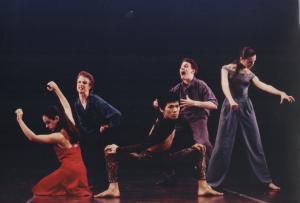‘What Fools these Mortals Be’ (1993)
Duration: 10’
For Roland D550 and pre-recorded track; contributors include Liz Kenwood-Herriott (oboe) and Mark Grabiec (electric guitar)
Choreography: Michael Keegan-Dolan
Lighting: Sebastian Petit
First performed at the Minerva, Chichester as part of the 1993 Ballet Central National Tour.
Created for the 1993 Ballet Central National Tour, Michael Keegan-Dolan’s ‘What Fools’ was a vivid choreographic interpretation of the lovers’ story in Shakespeare’s A Midsummer Night’s Dream orchestrated by a herbal-cigarette-smoking reptilian Puck.
Musically it is in the form of a Quodlibet, a musical form that rejoices in the alien, the unconnected and the completely random. There are many references to Mendelssohn, especially his wonderful overture for A Midsummer Night’s Dream, whose famous four chords both start and end this piece. There are also quotes and references to Cosi fan Tutte, appropriately considering its analogous plot. In fact much of the piece is a parody of early nineteenth century opera. To this end, for the recording many colleagues and friends were co-opted to make a contribution to the score, whether singing or playing, a kind of musical event a la Ricky Gervais, but entirely suitable to the ‘objets trouvées’ character of a quodlibet.
This piece is notable also for the fact that the music, apart from the beginning and the closing organ fugue, was almost entirely written after the choreography was done, being composed either to counts or off the video. Much of the reason for this was the late commissioning of the work, obliging both the choreographer and the composer to work at speed, the latter simultaneously working on Derek Williams’ Extenzion for Northern Ballet Theatre. This also might account for the very inclusive all hands on deck approach to creating and recording the score.
The live keyboard becomes prominent in the fugue, as the D550 Cathedral Organ sound was particularly good. The keyboard does play harpsichord as well, but at a supporting level, as the patch was considered too synthetic; the clavinova harpsichord that was used for the recording sounded much more authentic. The score’s eclectic nature meant that the Akai sampler came into its own, with snatches of Mozart, Verdi and even roosting owls becoming part of the patchwork score; this was at a time when all kinds of music, such as house music, were introducing sampled bites from other works, and the sampler was proving to be an essential piece of recording hardware. They are now mostly obsolete.


